Exploring Lahore in 6 days…
When I first told people I’m going to Pakistan their initial response was that of suspicion, concern and surprise… I was repeatedly asked “is everything okay? are you going to get married?’…. Holidaying in Pakistan was not on my bucket list and the last thing people would probably expect me to do, especially alone and by choice. Some asked, “of all the places you could possibly visit, why Pakistan?” you see, for a lot of us who are Pakistani by ethnicity, trips to Pakistan aren’t seen as a holiday per se, rather, an opportunity to visit family and attend somewhere in the range of fifty to a hundred dawats (family feasts). Not forgetting, the endless trips to the darzi (tailor) – the bane of my childhood trips. And, of course, ending the journey with a bout of viciously merciless diarrhoea as a result of eating the street food that you were advised against but physically couldn’t resist!
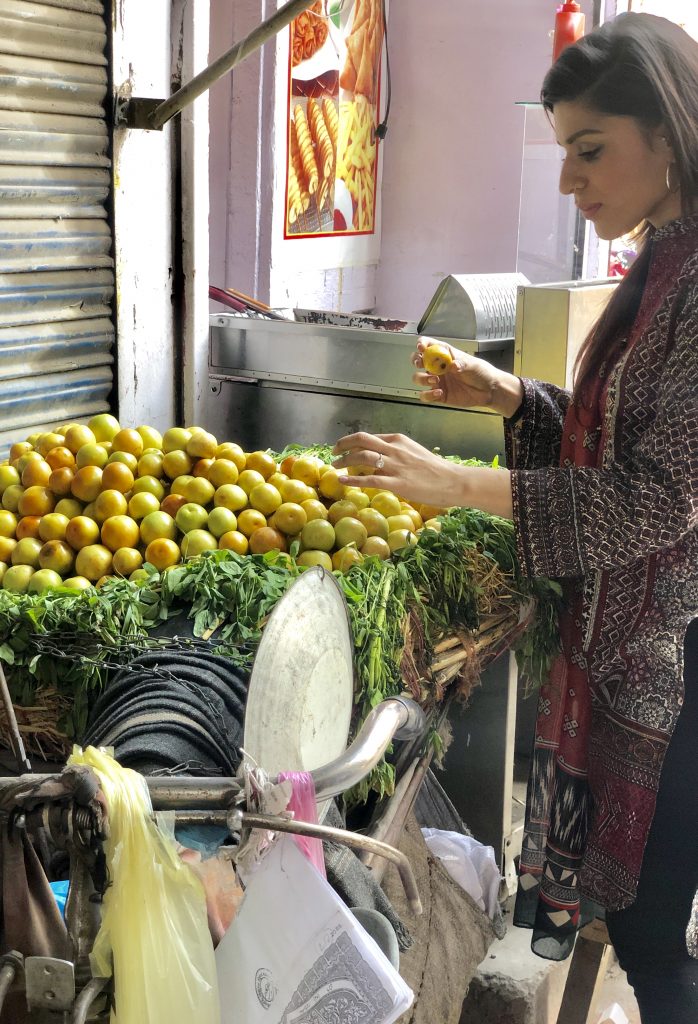
Ber (Ziziphus mauritiana) fruit cart
I knew this trip would be different, although (inevitably) amidst all the excitement, I was still nervous and pretty anxious about this trip. This was largely due to the horror stories I’ve heard about the dangers of travelling alone, particularly for girls. It certainly didn’t help that my Urdu (the official language of Pakistan) was/still is, even poorer as an adult than it was as a child (don’t ask!). People kept wishing me luck on the days leading up to my flight. I began to wonder, why exactly they were wishing me luck, was there something I was missing here guys?
I was visiting Pakistan after 14 years, without any family and I was visiting Lahore, a city I’ve heard so much about but have only ever briefly visited (and never had the chance to explore). I chose Lahore as my destination because of how rich it is in culture, heritage and history. It really did surpass my expectations in so many ways. Lahore has the perfect balance of East meets West and traditional meets modern. There is so much to see and absorb. This trip was literally life-changing for me in so many ways. I won’t get into a great deal about that because you’ll most definitely begin to snooze, so let’s cut the sleep worthy bits and get straight to the exciting stuff!
Day 1: SHALIMAR GARDENS
On arrival, I was taken aback by the chaos at the airport. An older lady was persistently smacking me on the arm, near the conveyer belt and muttering something in Punjabi (to this day, I have no idea what she was saying). I also very quickly realised that there would be no such thing as queuing or doing anything whatsoever in an orderly fashion for the next 6 days.
My friend Maaida and her beautiful family had come to welcome me from Gujranwala. Maaida would be staying with me for the duration of my trip and we’d be wandering Lahore together. She was familiar with the city so I was in good hands. I was INCREDIBLY jet lagged but I only had 6 days to see everything and was eager to fit it all in. I avoided the airline food (I could do an entire blog post on Pakistan International Airlines but I’ll spare you this time) so by now I was starvinnng! We stopped off at Café Barbera for a well-needed cappuccino and a spicy omelette before making our way to the first stop which would be Shalimar gardens.
I decided way before arriving in Lahore that my only mode of transport would be a Rikshaw or a horse and carriage (though the latter was scarce).

I love that they’re hand-painted by local artists and that they get you around traffic more efficiently. Unlike in a conventional taxi, on a rikshaw, you’ll get to experience the vibrant sounds of the buzzing city, which are all part of the fun and I didn’t want to miss out on any of that! I noticed motorbikes being a common mode of transport too. In fact. It was very normal to witness 4 or more people on one motorbike at a time (can I add, including new-born babies, which really wasn’t great for my blood pressure). Oh, I even observed sheep being transported on them (yes, actual living sheep!)
Shalimar Gardens (meaning abode of love) was a huge Garden exhibiting 410 fountains discharged into wide marble pools. There wasn’t much water about but I was visualising how much prettier it would all look if everything was in actual working order. The gardens were built in 1641 by the fifth Mughal emperor, Shah Jahan who is best known for his construction of the Taj Mahal in India. He was inspired by the Charbagh concept, which is a Persian quadrilateral garden arrangement based on the four gardens of paradise mentioned in the Quran. The architecture, the elaborate waterworks and intricate fretworks were breathtakingly beautiful and as an artist myself, I had a great sense of appreciation for them. The mastery that would have gone into the formation of something like this is still beyond me and it was all built in only a year!

Inside Shalimar Gardens
Since I wanted to fully embrace the culture and I rarely get to wear shalwar kameez (Pakistani dress) in London, being in Lahore was a good opportunity for me to purchase a few and make use of them during my trip. I was told Lahore is fairly progressive and wearing western clothing was fine, but who wants to come all the way to Lahore and wear jeans and shirts? It was too early in the trip for me to go to the huge mall everyone was talking about (Packages Mall) which just didn’t appeal to me at all. I assumed it would be just another huge mall like the ones in Dubai and London that are overpriced and tedious to get around! I was after the more local and authentic merchandise, so my best bet was to visit the popular Liberty market.
This market was almost a cross between a shopping complex and market and was laid out in a square type arrangement. It was colourful, vibrant and clean and I found I got harassed less by vendors as compared to the more traditional markets I’ve visited in the past. The market had a fantastic variety of local merchandise at very reasonable prices. It had shops dedicated to khusseh (traditional Pakistani embroidered shoes), which were the most stunning I have seen! I wanted them all but limited myself to a single pair! I kept reminding myself that my suitcase was the size of my laptop bag (maybe a slight exaggeration, but not far off!). Anyhow, In Liberty market, one would find restaurants, ajrak designs (traditional Sindhi prints), hand embroidered cashmere shawls, jewellery, bridal wear, home décor and so much more. If you had to choose a single place for your one-stop shop (assuming you weren’t fussed about high-end brands) this should be it! I got myself a few nice items from here that would see me through my trip!
Day 2: TOMB OF JAHANGIR
The Tomb of Jahangir is known to be the most magnificent Mughal structure after the Taj Mahal. Jahangir was the fourth Mughal emperor and the father of Shah Jahan. The site was on the outskirts along River Ravi in what seemed to be the run-down areas of Lahore. On arrival I was a bit bummed as I was asked to pay a considerably higher entrance fee than my friend, since they could recognise I wasn’t a Pakistani national (the cheek!) anyway, now I understood why I was repeatedly told by my friend not to speak in English (in my case, not speak at all!). Wearing Shalwar Kameez didn’t seem to help either. They can notice a tourist a mile off! We had a cool tour guide but he was speaking in heavy Punjabi so I was only able to understand dips and drabs of the info. For the most part, Maaida had to play interpreter, which couldn’t have been much joy (sorry Maaida!)
Upon entering the gates of the complex, we were greeted with a large garden that consisted of huge trees that we later found out have been there for hundreds and hundreds of years. Can you just imagine what these trees have observed over the eras? The gardens were again laid out in the Persian Charbagh style.
The interior of the site was embellished with striking floral frescoes and marble. The tombstone of Jahangir itself had the 99 names of God (according to Islam) engraved on it and these names were originally adorned with precious stones and gems, although most had been stolen over the years. Maaida and I wanted to climb to the top of the minaret, but “apparently” this wasn’t for public viewing (well, till we offered the guard a little tip!). The views from there were truly astonishing and insanely picturesque!
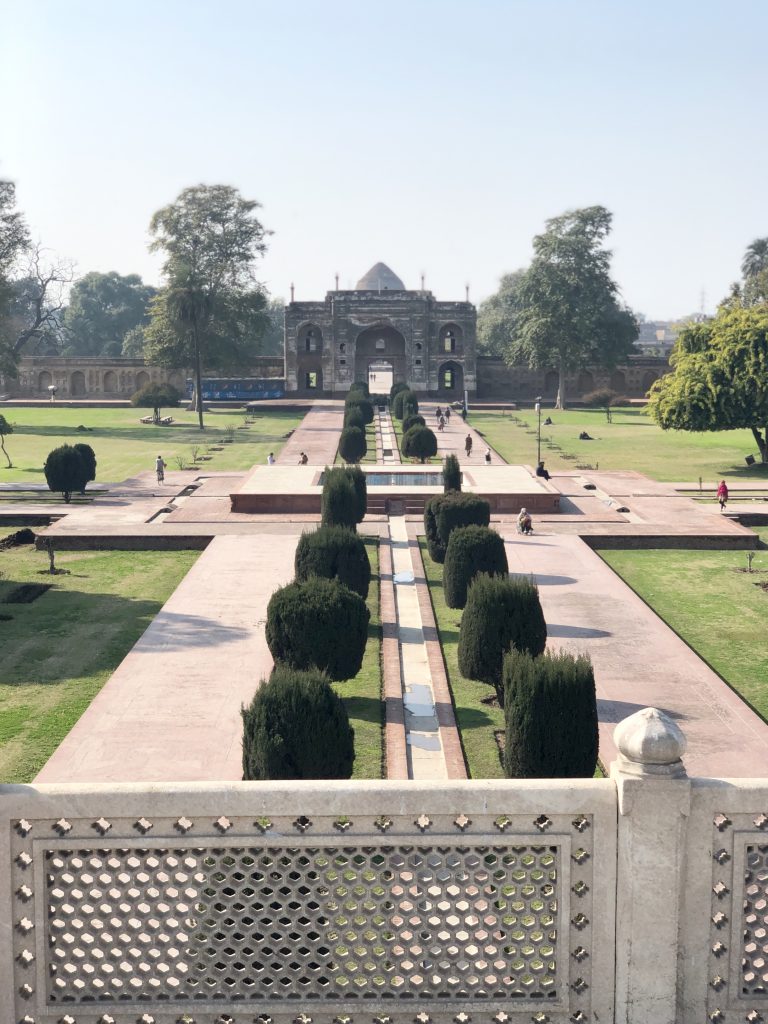
Charbagh style garden
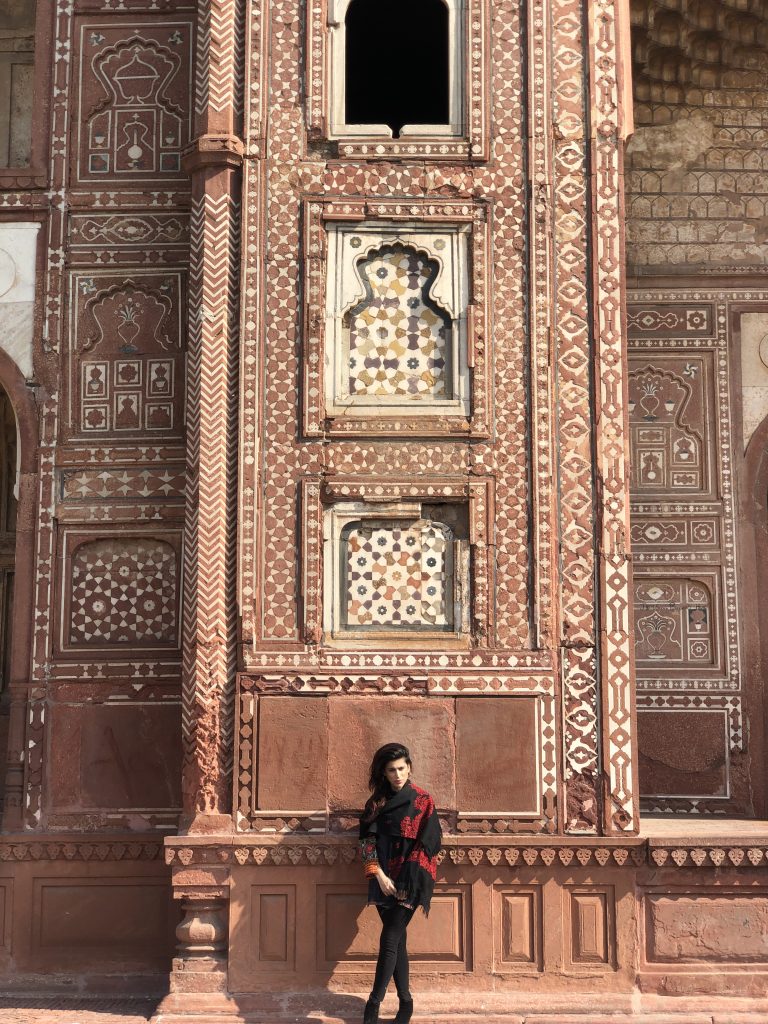
Exterior of Jahangir’s tomb
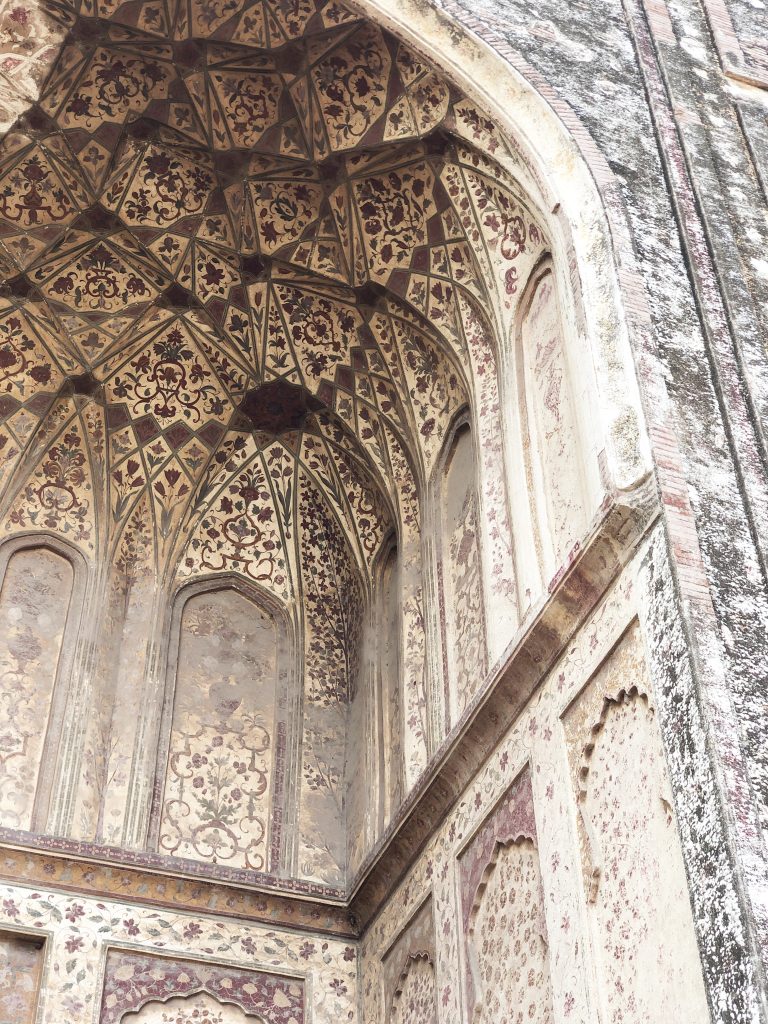
Interior of Jahangir’s tomb

The tombstone of Jahangir

View from the minaret
On leaving the site, I spotted some restoration work taking place. It was fascinating to see these highly skilled labourers doing their intricate carving handicraft with very little technical equipment and yet so much precision! One of the workers who was an elderly man told us he’d been working in the craft for 40 years! That is serious dedication right there!
I was craving more hot drinks than food on this trip (maybe because psychologically I knew I had to be careful with solid food!). I experienced an extraordinary craving for Pink Kashmiri chai which is a traditional Pakistani pink tea often served sweet or salty and can contain pistachios and cardamom. This tea is most popular in the northern sides of Pakistan and being half from the north myself, I was lucky enough to have had the real stuff some years ago! We headed to a café called chai khana hoping for an authentic version. This version of Kashmiri tea was salty to the taste which was definitely interesting although it’s fair to say, I definitely prefer my sweet beverages! I pretty swiftly fixed the situation with a large teaspoon of sugar!
Day 3: Anarkali/Bansi Mandir
I love traditional bazaars with charm and character and all the hustle and bustle that comes with them. The atmosphere of the Anarkali bazaar was in one word, quirky. Everything from the aromas to the sounds, to the overall ambience got me feeling like I’ve taken a trip back in time. This bazaar is one of the oldest surviving markets in South Asia and dates back to at least 200 years.

It was heavily crowded with locals, and displayed rows of stalls and shops that seemed to have no end! Vendors were selling anything from fairly fake Chanel slippers to seriously obvious fake t-shirts with a double ‘S’ in ‘Adidas’ (epic sight!). There were lines of stalls selling Abayas (Islamic dress), toys, costume jewellery and merchants selling fresh juices made from all types of fruits as well as food I’d never seen! It was honestly incredible!

What caught my eye amidst the chaos were some of the architectural styles of the buildings in the area. These sites were quite run down and weren’t preserved as well as they could have been, nonetheless were striking and the antiquity in them was instantly recognisable. One building, in particular, caught my eye. It comprised of a traditional arch framed by pillars and an elaborate balcony above the entrance, which was decorated with intricate woodwork. The locals working in the booth beneath told us it was a ‘mandir’ (Hindu temple) and were kind enough to take us on a little tour since we appeared to be so fascinated. We were directed up a narrow staircase, which led to the courtyard of the temple. I was hopeful that it would still be in use as a place of worship by the minority Hindu population of Pakistan and possibly as a tourist attraction. Instead, portions of it had been rented out to different families so we were unable to delve in further.

Outside the Mandir (Hindu temple)
The locals seemed to have little knowledge on the formation and history of the temple, but we learnt that a Pakistani Jew currently owned it and the building was believed to have been built during the colonial period, in the 1890’s.
Lastly, we visited the Tomb of Qutub ud-Din Aybak which was hidden amongst some of the busy alleyways of Anarkali. Qutub ud-Din Aybak was the founder of the Mamluk dynasty and the first sultan of the Delhi Sultanate. The entry door was decorated with fine geometric woodwork and the interior was made up of white marble and jhali (lattice screens).

The entry door of the tomb of Qutub ud-Din Aybak
On our way back to the hotel, I remembered a blog post I’d seen whilst in London about a Kashmiri cheesecake being served in a café called Scafe Bistro. I had to find it because I’d be mad not to, considering how crazy I am about Kashmiri tea. I was almost certain that they’d be unable to pull off a scrumptious Kashmiri cheesecake that ACTUALLY tastes like Kashmiri tea but I’m not about to go all the way to Lahore and not try my luck. Strangely, this amazing cheesecake (which had been blogged about and reached my Facebook feed all the way in London) wasn’t even on their menu. After asking the waiter about it, he explained it’s not something they put on the menu, but they do have it in the kitchen (weird!). Anyway, in a nutshell, it was delicious but tasted NOTHING like Kashmiri tea. I wish I could explain the taste but I can’t. It was unusual that’s all I can say. Unusual in a nice way.
Day 4: (Sunehri Masjid/ Naqsh School/Haveli Wazir Khan Mosque
So, by this point, I was halfway through my trip and panicking that there was so much more to see but such little time! As the subhead suggests, I tried to cram in as much as possible on my fourth day. We began by briefly visiting the University of Punjab. The university was the fourth university to be established by the British colonial authorities in the Indian subcontinent.

University exterior
I found the architecture of the University spectacular. It looked more like a palace than a place of study with its large balconies and projecting arched windows. Parts of the building was covered with vines and plants, giving it a real gothic feel. There was definitely a charm about the place.

University exterior
Sunehri masjid was situated within a busy bazaar, in the walled city of Lahore (old city). Let’s just say, this is probably one of those areas in which the “women travelling alone” thing could definitely apply! The area was jam-packed with stalls and heaving with crowds. It was similar to Anarkali in terms of its traditional vibe. However, it seemed far more congested and a bit more urban and “ghetto”.
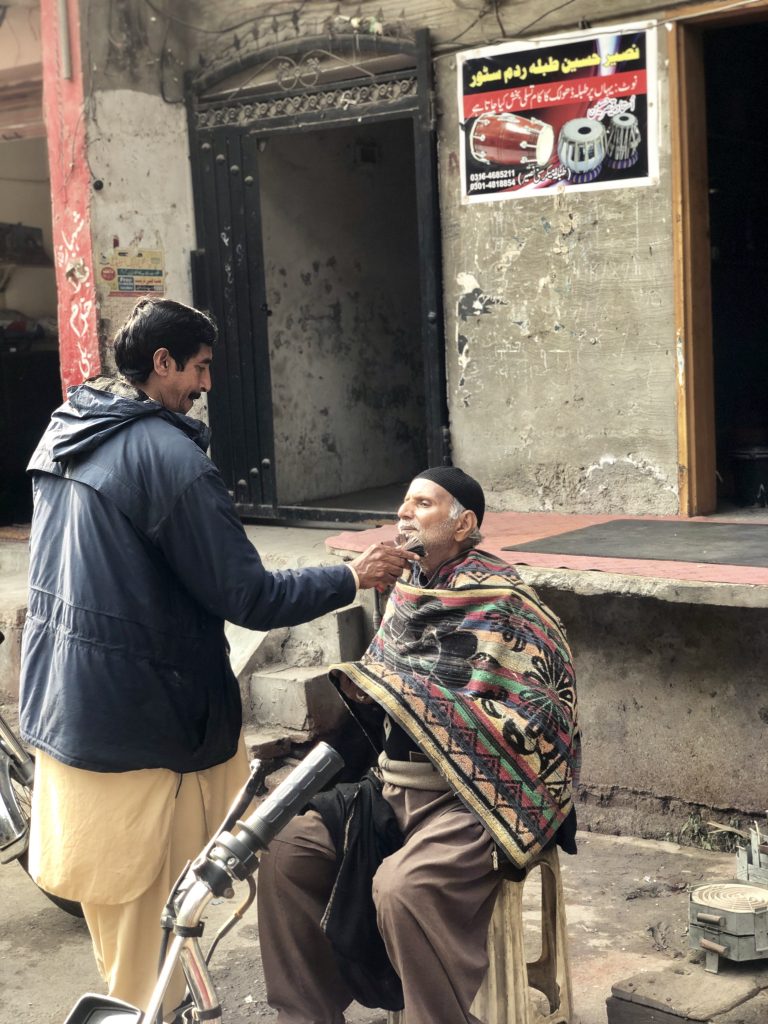
An outdoor barber in the bazaar
After walking through crowds and heavy traffic for what seemed like forever, we reached our destination. The building looked quite different to the traditional mosques I’ve seen. It reminded me of a traditional Sikh Gurdwara with its 3 golden domes, which is a common facet in Sikh religious architecture. On entering the building, we were presented with the courtyard, which had an ablution tank in the centre. Though the mosque was surrounded by complete chaos, once you climb the stairs of the mosque and enter, you feel a deep sense of tranquillity. I could probably have easily sat there all day, watching the flocks of pigeons gracefully circulate the area. It almost felt therapeutic.
The interior of the mosque was small in contrast to previous mosques I’d visited and was decorated with beautiful Mughal-era frescoes on the ceilings and walls. However, some of the areas had sadly been distastefully obscured with fans, lights and ugly clocks.

Interior of Sunehri Masjid
Our next stop was Wazir Khan mosque. This is a 17th-century mosque renowned for its intricate faience tile work known as kasha-kari and Mughal-era frescoes. The mosque was embellished with Persian inspired star-shaped flowers and grapevines and the colours adorning the interior where strikingly vibrant. Areas of the mosque were also adorned with sayings of the prophet and Quranic verses.

Exterior of Wazir Khan mosque

Interior of Wazir Khan mosque
Finally, we made our way to the Naqsh Art school and the Mubarak Haveli (traditional townhouse or mansion of architectural significance). If you have an appreciation for art and creativity, fit this into your itinerary! The school’s purpose is to preserve traditional artistic skills and is one of the only schools in the region that provides such opportunities to students.
The building included an art gallery quarter where you could view works from students or postgrads. These pieces included sculpture work, calligraphy and geometric paintings to name a few. They were available for people to purchase, and profits from purchases went back into financially supporting the school.
The Naqsh Art School is located in buildings attached to a Haveli. This one was known to be among the oldest and finest in Lahore. It had the original traditional features but due to restoration work, it had a slightly modern appeal too which I wasn’t expecting.

Courtyard of Haveli
I was proud of myself thus far for not succumbing to the temptation of street food and had even managed to avoid teas and fresh juices! I was however desperate for a traditional Karak Chai (traditional spiced tea) and had to find a safe option! The famous Pak tea house was close by, so we decided to make a quick visit. The tea was served at the perfect temperature and had just the right sweetness and strength, definitely the best and most authentic version of Karak chai I’ve probably had. Pak Teahouse is a simple modest café but is recognized for its history. Here you’ll find the hip creatives and students from the University nearby.
Day 5 Edhi foundation
Today was about putting all excursions aside and spending some time to reflect, appreciate, give back and love. By now I was really missing my two boys that I’d left behind as this was my first trip away from them both. After having my own children, my desire for helping underprivileged children grew and I’d always wanted to visit an orphanage, particularly in a developing country. It’s great being able to help from afar but I knew by being present and seeing poverty first-hand, this would certainly have a different kind of impact on me.
Before heading there, we made a quick visit to Aracadian Café where we had some dynamite shrimps (very tasty!) and a really good cup of cappuccino. This café was spacious and had a good ambience. The service was pretty good, and they had reliable wi-fi facilities (which was essential on my trip for face-timing my babies!).
Face-times concluded; we made our way to the orphanage. The Edhi foundation is a charity I had always been fond of and I was thrilled when the manager agreed for us to come and spend an afternoon with the children.
The Orphanage was for boys who had either been abandoned by their family or had run away/been taken away due to domestic or physical abuse.
When I walked in, it wasn’t quite what I had expected (in a good way!). The boys were all well dressed and groomed and were beaming with smiles. They were a little shy at first but opened up to us shortly after. Amongst them was an elderly man who had been left there by his daughter. The manager of the orphanage told us that although the orphanage was predominantly for children, if vulnerable adults were left there, they wouldn’t be turned away.
The centre was immaculate and spacious and not over congested with children. The beds were comfortable with fresh bed sheets and the kids even had a television in their rooms! The classrooms were commodious and had all the equipment kids would require to study adequately.

Classroom inside the Orphanage
The courtyard had a playing field where the boys would enjoy playing sports. We joined them for a game of cricket, which was a lot of fun. They found it incredibly funny that I couldn’t catch a ball to save my life and attempting to do so in a shalwar kameez (traditional dress) must have been entertaining in itself!
On leaving, I really wanted to give the kids a heartfelt hug. It seems like a simple gesture but I recently read an article online, which stated that we need 4 hugs a day for survival, 8 a day for maintenance and 12 hugs for growth. Now, I don’t know how much truth there is in this, but ever since reading it, I have tried my best to implement it in my family life. After all, what harm can a hug do? My one hug may not make a huge long-term difference to these boys, but it may have given them comfort for that split moment. I noticed how some of them gripped on to me. One child, in particular, seemed to be incredibly clingy and as I pulled away, he was refusing to let go. The manager explained that this boy who was from Peshawar was having the toughest time adapting to being away from his mother and would ask for her often. The reason for his abandonment, as with most cases was unknown. It was a truly emotional moment and the waterworks couldn’t really be helped BUT I am glad I had this opportunity and it gave me a lot of perspective.
I remember the boys had a distinctive scent from fragranced oil, which was on their hair. It wasn’t the sickly type of Amla oil that was usually dolloped on my hair as a kid but quite subtle and comforting actually. It was lingering on my hands for much of the day, even when I had left, which I cherished.
Day 6: (Badshahi Mosque, Lahore Fort, Wagha Border
Today was my final and most eventful day of cramming in as much as possible.
Our first stop was Badshahi Mosque. This renowned mosque is another great example of Mughal architecture and is the second largest mosque in Pakistan commissioned by Emperor Aurangzeb in 1671.
Just near the entrance of the mosque, we saw the tomb of Mohammad Iqbal who is considered to be the “Spiritual Father of Pakistan and one of the most important figures in Urdu literature.
When entering the gates, we were presented with a large sandstone paved courtyard, which can accommodate 100,000 worshippers. The mosque’s exterior is decorated with carved red sandstone, marble inlay and elaborate white marble all engraved with delicate floral designs.

Sandstone exterior of Badshahi mosque
The mosque is very picturesque and commonly used as a set for wedding photo-shoots. It had a very fairy-tale and dreamy feel about it and I felt like I needed half a day just to explore!

Badshahi Mosque interior

Interior of Badshahi mosque

Praying hall, Badshahi mosque
A stone’s throw away was the Lahore fort. I think this is one of those places which is so rich in history and culture that a visit is essential just for the sake of it! My visit here was brief due to time constraints but it was another majestic building displaying striking examples of Mughal architecture. The artwork throughout (as expected) was spectacular. Sheesh Mahal which translates to “palace of mirrors” is an ornate white marble pavilion within the fort which displays intricate and complex mirrors. A must see! (Even if you don’t have time to discover the rest of the fort).

Palace of Mirrors (Sheesh Mahal)
Located next to the Lahore fort and Badshahi Mosque was The Samadhi of Ranjit Singh. The building is a 19th-century building that houses the funerary urns of the Sikh ruler Ranjit Singh (1780 – 1839). The structure is managed by local Sikhs who were kind enough to give us access although the building was under heavy renovation work. The building combines elements of Sikh, Hindu, and Islamic architecture which was very interesting to see. Unfortunately, due to the renovation work, we were unable to access much of the area.

The Samadhi of Ranjit Singh
I met a lovely Sikh lady in the building who was there for worship with her family. We exchanged numbers and she invited me to her village near the outskirts of Lahore. It was heart-warming to see the coexistence of Muslims, Sikhs, and Christians in Lahore.
I promised myself before my trip that I wouldn’t come back with a bunch of silly souvenirs but just outside the Badshahi mosque and fort were a line of stalls selling the most beautiful and colourful hand-made items ever! They were selling embroidered bags and traditional Pakistani shoes with stunning mirror work, I ended up grabbing a bunch of bags, which cost me less than £7!
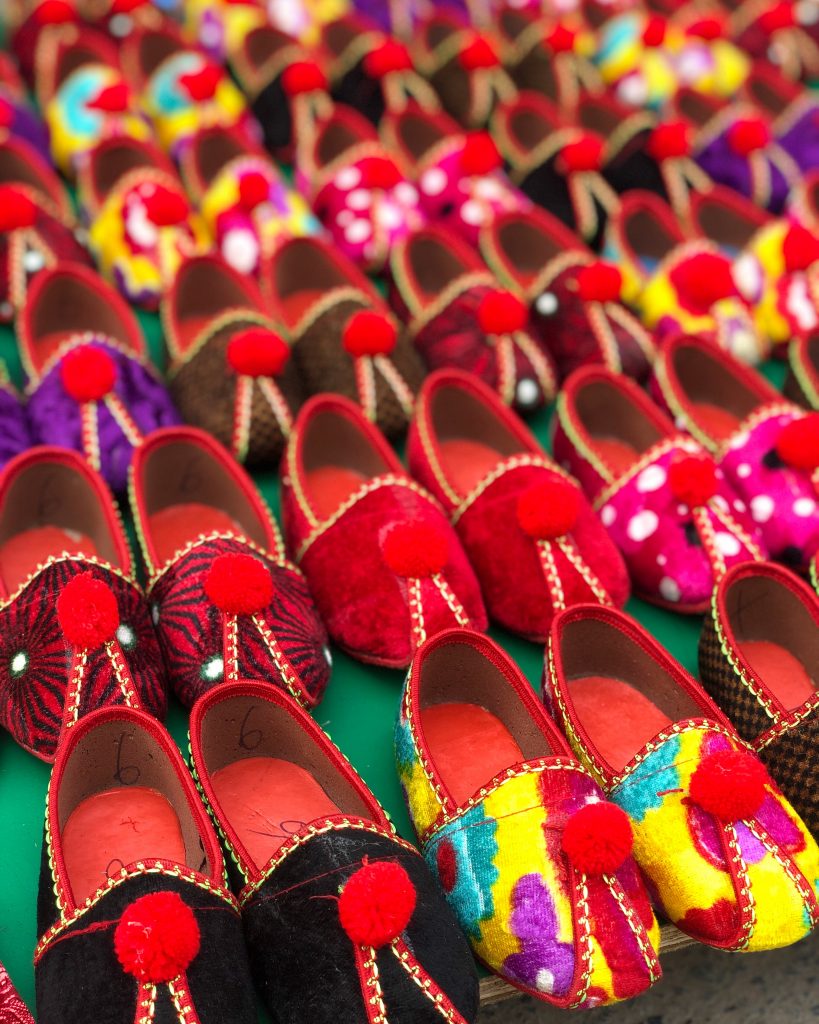
Hand-made by local craftsmen

I ended up giving him double just because I think he deserved it. He was a warm and friendly elderly man. I imagine people of his age in the UK would have retired long ago but perhaps he had no other choice. I honestly believe, with vendors like these, I don’t deem it appropriate to haggle. They stand outside in the blistering heat for the entirety of their day, grafting to make ends meet, and along we come thinking it’s okay to negotiate prices with them, to save a bit of cash? Okay, okay, they probably do charge us a little extra seeing as we’re tourists, but in my opinion, that really is ok. After all, this may be their only opportunity of the day to earn a decent wage.
After all of this adventure, you’d think we’d be shattered (we were!) but we had to fit in the Wagha border parade. If there is one thing I’d travel all the way to Lahore again for, it would be this!
Just before sunset, we made our way. The Wagah border is the perimeter that separates India from Pakistan. There were several security checks near the area which was expected but overall, we had no major issues getting in. I would advise you to try getting VIP access to make the process smoother. This was arranged by our hotel for us so I’m not entirely sure what the outcome would have been if we didn’t have this. Remember to also arrive at least half an hour in advance to avoid any delays that may take place at security checks. We were going to the border to attend the ‘lowering of the flags” ceremony which is a daily friendly military practice that the security forces of India and Pakistan have followed since 1959.

With the guards at the Wagah border
Extravagant and rapid dancelike movements characterize the practice and raising legs as high as possible (which was very entertaining and impressive to watch). I was excited to witness female Pakistani soldiers opening the parade and doing so with such grace and pride. The atmosphere at the border was electrifying. The place was blaring with Pakistani anthems, loud drums, flamboyant cheering and excited children. Before the parade begun, a very talented young man with one leg provided an elaborate whirling dervish dance to entertain attendees.
As the sun was setting, the large iron gates at the border were opened and the two flags were lowered simultaneously. The flags were then folded and the ceremony ended with a parting that included a brisk handshake between soldiers from both sides.
The parade was short, sweet, enjoyable and entertaining. One of the best experiences of my life and one which you cannot miss if you visit Lahore!

The official drum player at the Wagah border
So, we had fit SO MUCH in today. We were exhausted but feeling rather productive. It was time to make our way towards the famous food street in order to fill our bellies! Food street is literally its namesake; a line of restaurants (as opposed to stalls), their hygiene levels seemed promising. We had dinner at the ever so stunning Haveli restaurant, which is known around Lahore as one of the most prestigious (and rightly so) places to dine. The rooftop restaurant had a dazzling view of the city and exposed the best angles of the Badshahi Mosque. The sight was like something out of a magical storybook. I have never experienced anything like it!
The menu was substantial with an excellent variety. The service and entertainment were on point too. Prices were on the more costly side for Pakistan but if you are comparing them to London prices, it was fairly cheap, especially for a restaurant that deserves a 10 out of 10 rating! Our eyes were bigger than our tummies and we ended up ordering a large mixed grill, cheese naan bread and various other starters and finished off with some traditional malai kulfi (a Pakistani extra creamy ice-cream!).
My final thoughts
I was sad my trip had come to an end but so grateful I had the chance to have this experience and reconnect with my roots. I am super eager to learn Urdu now too! Hopefully, this will make my next trip even better!
The visit got me reflecting on the history we have here in Pakistan and the treasures we encompass, which I know I, nor most of my friends back home in London know/knew about. If we could restore and preserve what we have, I feel it would be great for tourism and subsequently increase employment, which would, in turn, reduce poverty. I feel hopeful that by my next visit, I’ll see some improvements on this front. I hope this blog post will have you consider Lahore as your next holiday spot! xx
